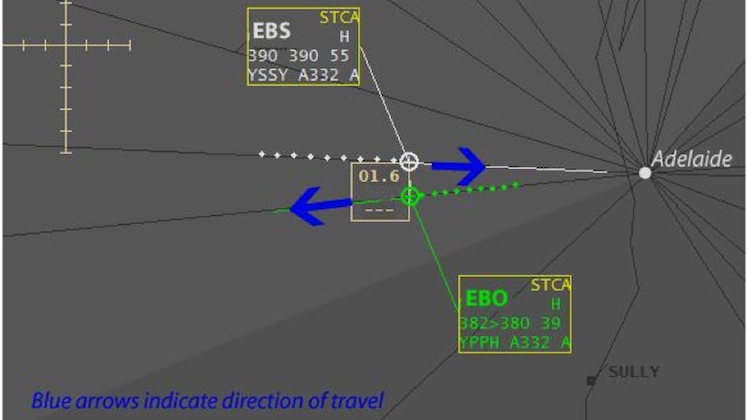
Investigators have been unable to figure out why a traffic collision avoidance system (TCAS) unit on board a Qantas Airbus A330-200 failed to warn pilots about a loss of separation incident in September 2013, the Australian Transport Safety Bureau (ATSB) says.
The incident on September 20 2013 involved VH-EBS operating from Perth to Sydney and VH-EBO flying westwards from Sydney to Perth.
Both aircraft were near Adelaide when VH-EBO requested air traffic control clearance to climb to 40,000 feet, from 38,000 feet.
Meanwhile, VH-EBS was travelling at 38,000 feet.
Air traffic control cleared VH-EBO to climb, triggering an alert both on the flightdeck of VH-EBS and at the air traffic controller’s station.
The ATSB said in its final report the air traffic controller “later reported that they had quickly identified that the routes of the aircraft were diverging and there was low likelihood of collision, but that a loss of separation had occurred”.
Recorded data from the two aircraft showed the minimum vertical separation was 650 feet, when VH-EBS and VH-EBO were 4.1nm (7.6km) apart laterally. The minimum lateral separation was 1.6nm (3km) when the aircraft were 870 feet apart vertically.
“The ATSB determined the en route air traffic controller did not adequately assess the traffic for potential conflicts before issuing a climb instruction to the EBO flightcrew,” the ATSB said.
“The air traffic control computer system subsequently alerted the controller to the conflict and they promptly commenced compromised separation recovery actions.”
The flightcrew of EBS responded to the resolution advisory (RA) with the captain initiating a climb at a rate of 800-1,000 feet per minute “by a gentle manoeuvre, which would be unlikely to be detected by the passenger cabin as a collision avoidance action”.
However, the ATSB report said the flightcrew of VH-EBO “did not see EBS on their TCAS display” and did not receive a traffic advisory (TA) or resolution advisory (RA).
Also, the aircraft’s TCAS received “no indications” of a Boeing 747 and Boeing 737 that VH-EBO passed later in the flight and which were sighted visually by the pilots, indicating its TCAS computer had malfunctioned.
The aircraft’s TCAS unit was tested upon arrival in Perth and a full system test was conducted after it returned to Sydney, where there was a “failure identified between ATC transponder 2 and the TCAS computer and directional antennas.”
The components that had failed were sent to the manufacturer in the US for further testing that was witnessed by the US National Transportation Safety Board.
“The testing did not identify any incorrect or anomalous findings,” the ATSB said.
“The failure of the TCAS system on EBO to detect EBS and produce an RA and TA was not explained and the equipment manufacturer considered it to be a unique event.
“The manufacturer was not aware of any other such events.”
The ATSB noted this was a very rare occurrence and VH-EBO had other systems to track any potential loss of separation.
“As EBO’s transponder was functioning correctly, the aircraft remained an eligible and identifiable target for the defences provided by other aircraft’s TCAS and the ATC computer system’s conflict alerting function,” the ATSB said.
The ATSB report also “identified a safety issue relating to the convergence of many published air routes overhead Adelaide”.
“Airservices Australia is undertaking a review of air routes and of the Australian airspace design that contributes to risk,” the ATSB said.
“There is also consideration to providing more flexible route structures using modern navigation technology to create traffic directional flows and remove convergence points.”















